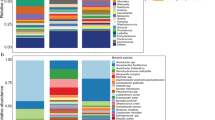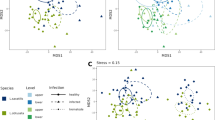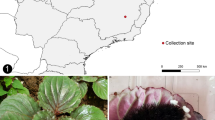Summary
A series of experiments were carried out with the endophagous egg parasiteTelenomus fariai on its hostTriatoma phyllosoma pallidipennis to determine the possible role of intraspecific competition by the parasite progeny in population regulation of the parasite. Eight parasite densities (1, 3, 5, 10, 20, 30, 40, and 50 individuals per vial) were used, and the design of sequentially sacrificed replicates applied. Survivorship curves for each density indicated smaller number of progeny per host at higher densities, and the shapes of the curves suggested a relatively early mortality process.Morris' linear regression technique for determining within-generation density-dependence was used, and the results showed that only larval mortality could be identified as density dependent. The same technique applied within the larval stage proved that only mortality of larvae in their second, third, and fourth day of development were responsible for population regulation. The applicability of the technique, as well as the relevance of the results for natural population, is discussed.
Similar content being viewed by others
Literature Cited
Abalos, J. W. andP. Wygodzinsky (1951) Las Triatominae argentinas (Reduviidae, Hemiptera).Universidad Nacional de Tucumán, Instituto de Medicina Regional, Publicación No. 601,Monografía No.2. 178 pp.
Bosque, C. andJ. E. Rabinovich (1978) Population dynamics ofTelenomus fariai (Hymenoptera: Scelionidae), a parasite of Chagas' disease vectors. VII. Oviposition behavior and host discrimination.Can. Ent. (in press).
Bryant, E. G. andS. R. Sokal (1967) Computing a population budget from sequentially sacrificed, replicated cultures.Res. Popul. Ecol. 9: 10–18.
Costa Lima, A. Da (1927) Nota sobre oTelenomus fariai, novo Sceliónido parásito endófago dos ovos deTriatoma megista (Burm).Sciencia Med. 5: 450–452.
Costa Lima, A. Da (1928) Notas sobre la biología deTelenomus fariai, Lima.Mem. Inst. Osw. Cruz. 21: 201–209.
Dreyfus, A. andS. M. E. Breuer (1943) Unicidade ou dualidade dos machosTelenomus fariai.Rev. Brasil Biol. 3: 431–441.
Dreyfus, A. andS. M. E. Breuer (1944) O sexo nos hymenopteros arrenotocos. Biología, determinaçao do sexo e ciclo cromosómico do microhimenóptero parásitoTelenomus fariai Lima.Bol. da Fac. de Univ. S. Paulo. Biología Geral No. 5. 103 pp.
Fisher, R. C. (1963) Oxygen requirements and the physiological suppresion of supernumerary insect parasitoids.J. Exp. Biol. 40: 531–540.
Kuno, E. (1971) Sampling error as a misleading artifact in “key factor analysis”.Res. Popul. Ecol. 13: 28–45.
Lumbreras, H., J. Arrarte andB. Guevara (1955) Control biológico de los vectores de la enfer. medad de Chagas. La presencia delTelenomus fariai infectando huevos dePanstronglus herreri en el departamento de San Martín.Rev. Med. Per. No.35: 63–73.
Mazza, S. (1942) Consideraciones sobre la enfermedad de Chagas en Bolivia.La Prensa Med. Argentina. Publ. (36): 26–58.
Mazza, S. andS. M. E. Jörg (1938) Tercera nota sobre “Triatomidae” (Hemip. Het. Reduvioidea) Argentinos.Mis. Est. Pat. Reg. Argent. Publ. 36: 26–58.
Morris, R. F. (1959) Single-factor analysis in population dynamics.Ecology 40: 580–588.
Morris, R. F. (1963a) The dynamics of epidemic spruce budworm populations.Mem. Entom. Soc. Canada No. 31, 332 pp.
Morris, R. F. (1963b) Predictive population equations based on key factors.In E. J. Leroux et al., (eds.), Population Dynamics of Agricultural and Forest Insect Pests, pp. 16–21.Mem. Entom. Soc. Can. No. 32.
Peláez, D. (1944) Algunas notas sobre el hallazgo en México de un microhimenóptero parásito de huevos deTriatoma pallidipennis (Stal).Ciencia 5: 29–33.
Pellegrino, J. (1950a) Nota sobre o parasitismo de ovos deTriatoma infestans, ePanstrongylus megistus pelo microhimenópteroTelenomus fariai Lima, 1927.Mem. Inst. Osw. Cruz. 48: 674–686.
Pellegrino, J. (1950b) Parasitismo experimental de ovos de varias especies deTriatoma pelo microhymenópteroTelenomus fariai Lima, 1927.Mem. Inst. Osw. Cruz. 48: 674–686.
Peterman, R. M. (1978) Testing for density dependent marine survival in pacific salmonids.J. Fish. Res. Board Can. (in press).
Pinto, C. (1942) Tripanosomiasis Cruzi (Doença de Carlos Chagas) no Rio Grande do Sul, Brasil.Mem. Inst. Oswaldo Crnz 37: 443–536.
Rabinovich, J. E. (1971) Population dynamics ofTelenomus fariai (Hymenoptera: Scelionidae), a parasite of Chagas' disease vectors. V. Parasite size and vital space.Rev. Biol. Trop. 19: 109–120.
Ricker, W. E. (1954) Stock and recruitment.J. Fish. Res. Board Can 11: 560–623.
Salt, G. (1961) Competition among insects parasitoidsSymp. Soc. Exp. Biol. 15: 96–119.
Varley, G. C. andG. R. Gradwell (1963) Predatory insects as density dependent mortality factors.In:J. A. Moore (ed.), Proc. XVI Int. Congress Zool. Volume 1, p. 240.
Varley, G. C. andG. R. Gradwell (1968) Population models for the winter moth.In:T. R. E. Southwood (ed.),Insect Abundance, pp. 132–142. Blackwell Sci. Publ., Londn.
Zeledón, R. (1957) Sobre la biología delTelenomus fariai Lima, 1927 (Hymenoptera: Scelionidae), parásito endófago de huevos de algunos Triatominae.Rev. Biol. Trop. 5: 1–17.
Zeledón, R., A. Zúñiga andJ. C. Swartzwelder (1965) Hallazgo deTelenomus fariai en San Rafael de Alajuela. Algunas observaciones sobre la ecología de este microhimenóptero.ler. Congr. Centroamer. Microbiol., San Jose, Costa Rica, Dic. 1965.
Author information
Authors and Affiliations
Rights and permissions
About this article
Cite this article
Escalante, G., Rabinovich, J.E. Population dynamics ofTelenomus fariai (Hymenoptera: Scelionidae), a parasite of Chagas' disease vectors IX. Larval competition and population size regulation under laboratory conditions. Res Popul Ecol 20, 235–246 (1979). https://doi.org/10.1007/BF02512629
Issue Date:
DOI: https://doi.org/10.1007/BF02512629




